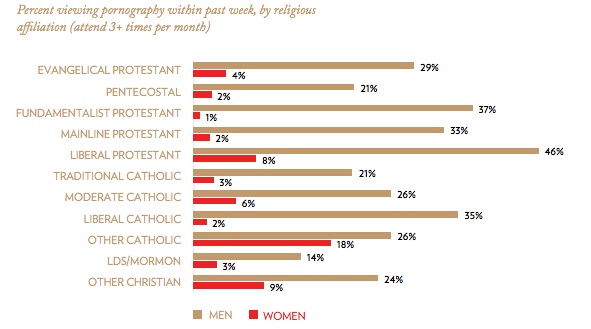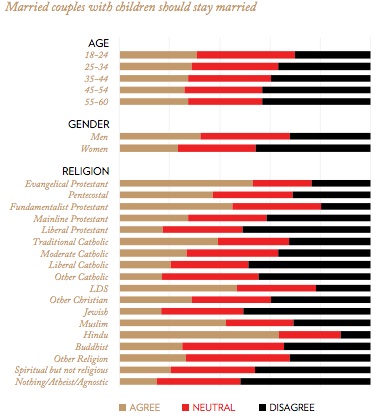Mormons’ Sexual Attitudes Explored in New Survey
A new survey “Relationships in America,” conducted by the Austin Institute for the Study of Family and Culture, sheds light on Mormon intimacy and ideas surrounding topics such as pornography, cohabitation and premarital sex.
The survey highlighted several religions and how they affect American society and attitudes about marriage, divorce, cohabitation, sexual behavior, abuse and domestic violence. Respondents of the survey were asked a variety of questions regarding religion and relationships.
The following is a list of categories that were mentioned in the study.
PORNOGRAPHY

The survey revealed that 43 percent of American men and 9 percent of American women report watching pornography weekly. However, traditional Catholics, Mormons, and Pentecostals report the lowest rates of pornography viewing, shown above.
FREQUENCY OF SEX
Married Americans reported having sex an average of 1.2 times per week, or just about five times a month, while cohabiting couples reported 1.6 times per week (or about 6.5 times per month). Individuals who’ve never been married reported a much lower average of 0.6 times a week.
PREMARITAL SEX
Those that are religiously active report significantly less cases of premarital sex. Those reporting their religion as “Atheist” or “Spiritual but not religious” report the highest levels of premarital sex, while Mormons report the lowest levels.
SEXUALLY INACTIVE MARRIAGES
Denise Donnelly of Georgia State University stated in “Journal of Marriage and Family” that, “habituation may be at fault: while sex may be exciting at first, over time one becomes accustomed to sex with a spouse, until eventually what once was exciting is now rather dull. At first glance it would appear that habituation—as measured by length of marriage—may be responsible for sexual inactivity in relationships.” However, the survey stated that there was actually a positive correlation to sexual activity and age.
As length of marriage increases, sexual activity increases.
WHICH GENDER IS MORE INTERESTED IN MARRIAGE?
Men are less likely to want to get married, and their girlfriends overestimate their enthusiasm. Men downplay their interest in getting married on surveys, and it may be a possibility that men and women are both poor judges of the level of enthusiasm of their partners for marriage. Overall, men perceive women as more interested in marriage.
ONE NIGHT STANDS – NONCOMMITTAL SEX
Mormons oppose casual sex the most at 89 percent, while Jewish respondents are the most tolerant of noncommittal sex at 54 percent. Approval rates for casual sex are highest among those who claim no religious affiliation, with 71 percent approval of those who say their religious affiliation is “Nothing/Atheist/Agnostic.”
COHABITATION
44 percent of Americans agree that cohabitation is a good idea for couples considering marriage in order to decide whether or not they will be compatible enough for marriage. However, out of all of the religions, Mormons are the most opposed to cohabitation, with a 76 percent disapproval rate.
SHOULD COUPLES STAY TOGETHER FOR THE SAKE OF CHILDREN

Americans are split on this issue: just under 40 percent disagreed, while 28 percent agreed, and one-third were on the fence. Younger Americans are more likely to say couples should stay together than their older counterparts. Meanwhile, men are more likely than women to say that staying together is the right thing to do.
POLYAMORY
What is the difference between Polyamory and Polygamy? Polygamy means that an individual has many marriage partners whereas polyamory means that an individual has many lovers at the same time.
Most religions are opposed to polyamory. The vast majority of Muslims disapprove of romantic and sexual unions involving three or more adults, although polygamy is permissible under Islam. Mormons are also very opposed to polyamory. Jews and Buddhists are split on the issue, while those who report no religious affiliation are the most likely to think polyamorous relationships are acceptable.
CHURCH ATTENDANCE
Mormons report much higher attendance than any other group, at 80 percent attendance weekly. Protestants are slightly more likely to say they attend services than Catholics, a recent change. At just 22 percent attendance in a given week, Jewish Americans are notably less likely to show up to the synagogue than their Christian peers are to be in church.
TOP RELIGIOUS STATES
Of the top 10 states in church attendance six are in the south, and three are in the Mountain West region. Utah, with its majority Mormon population, leads the nation in attendance at 65 percent religious attendance in a week. The second state, Arkansas is at 51 percent.
BELIEF IN LIFE AFTER DEATH
Mormons reported the highest rate of belief in a conscious afterlife at 98 percent, followed by evangelicals, Pentecostals, and fundamentalist Protestants. Among major religious groups, Mormons expressed the highest levels of belief in heaven and hell.
HAPPINESS
There is a connection between happiness and religious practices. Research has suggested that religious faith offers significance and meaning to life and also offers coping mechanisms which can improve physical and emotional health.


